
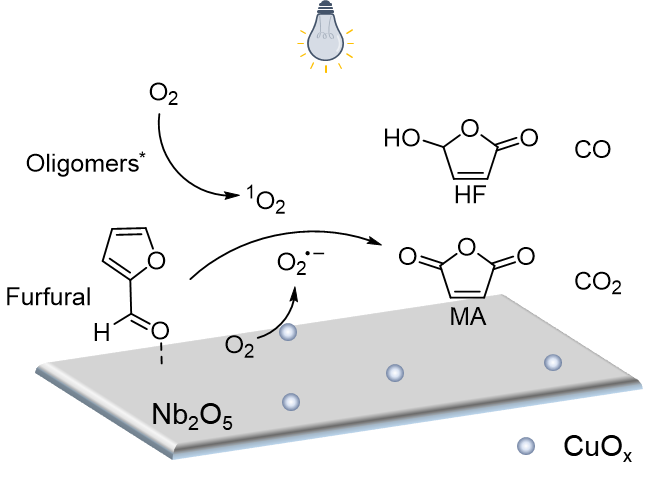
Puning Ren, Yue Zhou, Kaiyi Su, Lulu Sun, Nengchao Luo*, and Feng Wang
Chem Asian J., 2023, e202300732, DOI: 10.1002/asia.202300732
Maleic anhydride (MA) is an important polyester monomer that can be produced from oxidizing renewable furfural derived from biomass. However, MA generation from furfural requires harsh reaction conditions, and suffers from low efficiency and solvent corrosion. Herein, we design a Nb2O5 photocatalyst loaded of highly dispersed CuOx (CuOx/Nb2O5), which selectively catalyzes furfural oxidation to MA and the precursor (5-hydroxy-2(5H)-furanone, HF). Due to CuOx loading and forming a complex of ligand to metal charge transfer (LMCT) between the Nb2O5 surface and adsorbed furfural, the CuOx/Nb2O5 absorbs visible light to activate furfural though Nb2O5 has a large band-gap energy (3.2 eV). Singlet oxygen (1O2) is the key active species for C−C bond cleavage and CO generation. MA and HF is produced with a combined yield of 59% under optimized conditions. This work provides a mild way to provide renewable maleic anhydride via oxidative C−C bond cleavage.

Meijiang Liu, Hongji Li, Jian Zhang, Huifang Liu,* and Feng Wang*
Angew. Chem. Int. Ed. 2023, doi.org/10.1002/anie.202315795
Valorization of biomass-derived polyols into high-value-added ethanolamines and ethylenediamines is highly attractive. Herein, we report a one-step photocatalytic protocol to convert bio-polyols into a 60 % yield of ethanolamines and ethylenediamines over a multifunctional Cu/TiO2 catalyst. This catalyst enables a tandem process of photocatalytic polyol C−C bond cleavage and reductive amination in one pot at room temperature, and also allows the selective conversion of various bio-polyols and amines. Mechanistic studies revealed that photogenerated holes in TiO2 promote the retro-aldol C−C bond cleavage or oxidative dehydrogenation of polyols, and photogenerated electrons accumulate on small-sized Cu clusters, which facilitate the reductive amination via hydrogen transfer and prevent the H2 generation. This strategy provides new opportunities for the development of non-noble metal photocatalysts and methods of biomass conversion under mild conditions.
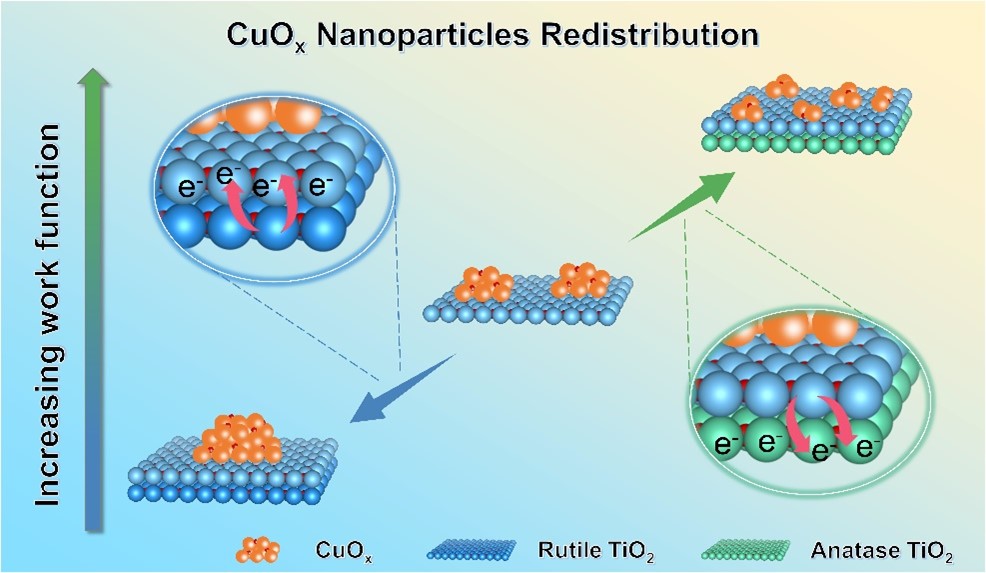
Xuezhong Nie, Yehong Wang,* Junju Mu, Jianyu Han, Huixiang Li, Nengchao Luo, Zhipeng Huang, Qiang Guo, Ning Li, Jian Zhang, Ning Li, and Feng Wang*
ACS Appl. Mater. Interfaces 2023, 15, 48168−48178. DOI:10.1021/acsami.3c10035
Nanoparticles exhibit unique catalytic performance, depending on their nanoscale size. However, controlling the particle size of the supported catalysts is still challenging. Here, we present a method for tunable redistribution of CuOx nanoparticles on rutile TiO2 support by physically adding pristine TiO2. The redistribution is driven by the work function difference (WFD) between the TiO2 support and the TiO2 additive, both of which exhibit distinct values, as determined through Kelvin probe force microscopy. Addition of TiO2 with lower work function (rutile) results in nanoparticle aggregation, while addition of TiO2 with higher work function (anatase) results in smaller CuOx on TiO2. The increase in particle size and electron density of CuOx, driven by the addition of rutile TiO2, promoted the complete conversion of nitrobenzene (100%) within 5 h. This is 2.7 times that of dispersed and degraded CuOx driven by mixing with anatase TiO2 (36.9%).

Dongxia Jiao, Jinghua An, Huixiang Li, Zhipeng Huang, Yehong Wang*, and Feng Wang*
Chin. J. Catal., 2023, 53, 161-170. DOI:10.1016/S1872-2067(23)64518-8
The direct formylation of amines with CO is an ideal way to produce formamides. However, the conversion of secondary amines via this process remains a challenge owing to their low reactivity. In this study, a relay catalysis strategy was developed to convert dimethylamine to N,N′-dimethyl formaldehyde (DMF) over a Ru-hydroxyapatite (Ru-HAP), with methylamine as a promoter. Through the relay catalysis of RuOx and HAP, the formylation of dimethylamine consists of two steps: (1) direct formylation of methylamine with CO to produce intermediate methylformamide (MF) over RuOx species, and (2) transformylation reaction of dimethylamine with the generated MF to produce DMF under the acid-base catalysis of HAP. Up to 82% yield of DMF was achieved, which is higher than that with direct formylation of dimethylamine (32%). The lower environmental impact factor suggested that the relay strategy not only decreased the waste of DMF production, but also lowered the energy consumption for separation.
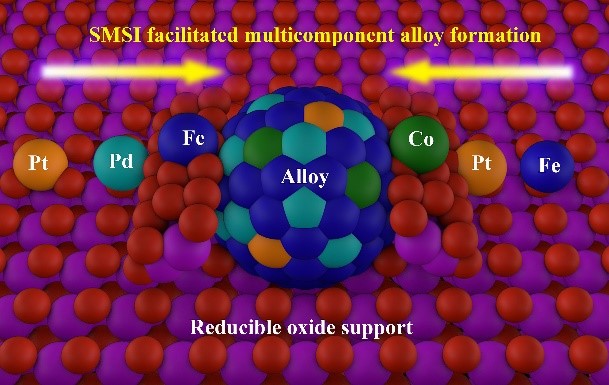
Jianyu Han, Jingyi Yang, Zhixin Zhang, Xunzhu Jiang, Wei Liu*, Botao Qiao*, Junju Mu*, and Feng Wang
J. Am. Chem. Soc., 2023, DOI:10.1021/jacs.3c07915
Multicomponent alloy (MA) contains a nearly infinite number of unprecedented active sites through entropy stabilization, which is a desired platform for exploring high-performance catalysts. However, MA catalysts are usually synthesized under severe conditions, which induce support structure collapse and further deteriorate the synergy between MA and support. We propose that a strong metal–support interaction could facilitate the formation of MA by establishing a tunnel of oxygen vacancy for metal atom transport under low reduction temperature. PtPdCoFe MA is readily synthesized on anatase TiO2 with the help of SMSI, which exhibits good catalytic activity and stability for methane combustion. This strategy demonstrates excellent universality on various supports and multicomponent alloy compositions. Our work not only reports a holistic synthesis strategy for MA synthesis but also offers a new insight that SMSI plays a vigorous role in the formation of alloy NPs on reducible oxides.
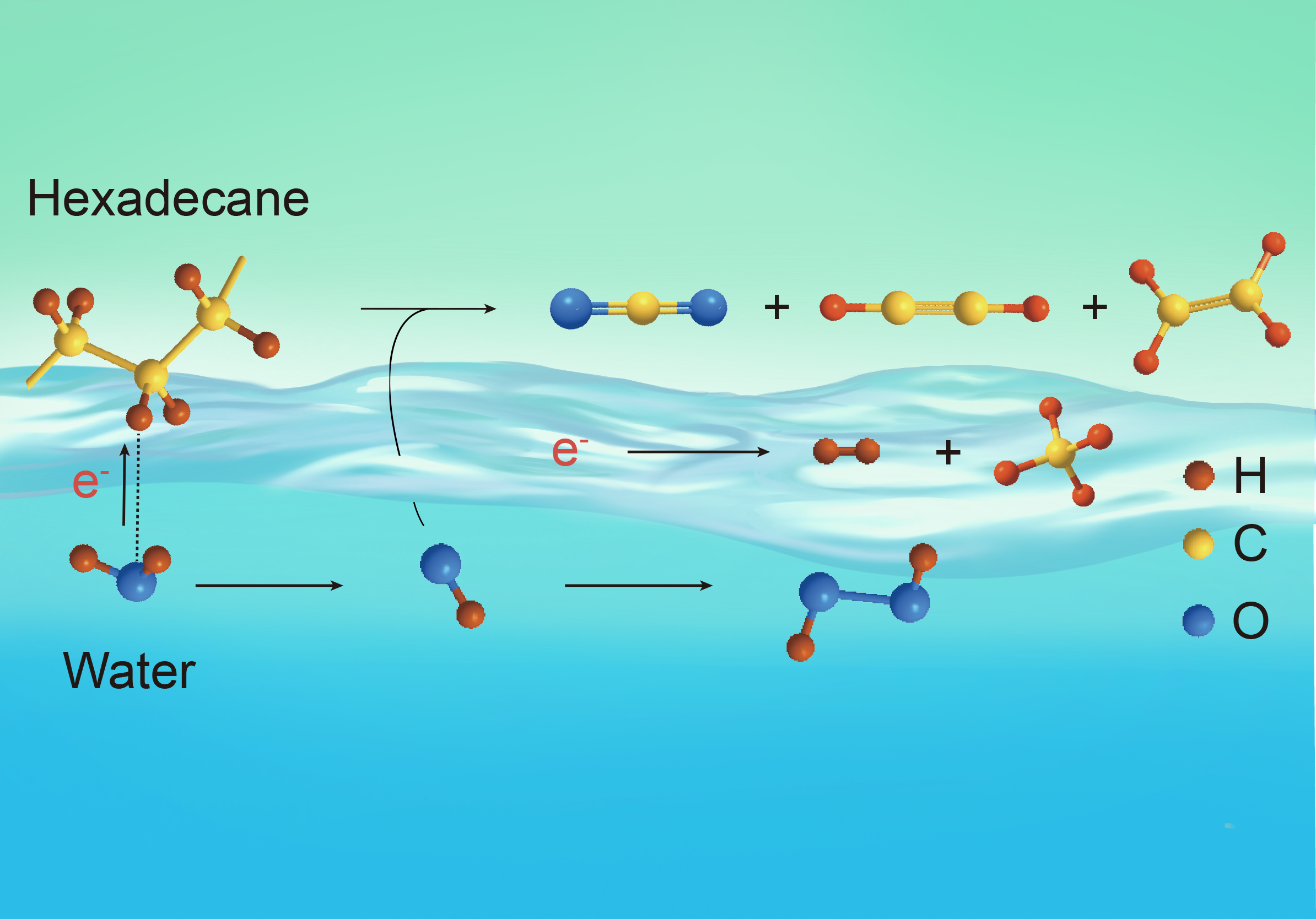
Xuke Chen, Yu Xia, Zhenyuan Zhang, Lei Hua, Xiuquan Jia*, Feng Wang, and Richard N. Zare*
J. Am. Chem. Soc., 2023, DOI: 10.1021/jacs.3c07445
Oils are hydrophobic, but their degradation is frequently found to be accelerated in the presence of water microdroplets. The direct chemical consequences of water-oil contact have long been overlooked. We show that aqueous microdroplets in emulsified water-hexadecane (C16H34) mixtures can spontaneously produce CO2, •H, H2, and short-chain hydrocarbons (mainly C1 and C2) as detected by gas chromatography, electron paramagnetic resonance spectroscopy, and mass spectrometry. This reaction results from contact electrification at the water-oil microdroplet interface in which reactive oxygen species are produced, such as hydrated hydroxyl radicals and hydrogen peroxide. We also find that the H2 originates from the water microdroplet and not the hydrocarbon it contacts. These observations highlight the potential of interfacial contact electrification to produce new chemistry.

Yuda Zhang, Yehong Wang*, Xian Guan, Huixiang Li, Xuezhong Nie, Yafei Liang, Xiaolei Bao, Xiaoqiang Li*, Feng Wang*
Journal of Catalysis, 426,2023, 86-95, DOI: 10.1016/j.jcat.2023.06.030
Ethyl acetate, as an important organic solvent, can be produced via ethanol dehydrogenation-condensation route with 96% atomic economy and environmental friendliness. Although CuZr-based catalysts have been widely used in this reaction, high ethyl acetate selectivity with satisfied ethanol conversion remains a great challenge. Herein, an efficient CuCeZr solid solution catalyst is developed and realize the selective synthesis of ethyl acetate from ethanol. The CuCeZr catalyst with 10 wt% Ce doping shows the highest selectivity (87.5%) and 55.9% ethanol conversion, which is superior to other reported CuZr-based catalysts. The characterization and reaction results suggest that the Ce doping enhanced the formation of Cu (I) species to improve the selectivity of ethyl acetate. Moreover, it decreases the amount of strong acid-base sites, which suppresses the self-condensation of acetaldehyde and dehydration process, reducing the production of C4 by-products.

Jianyu Han, Zhixin Zhang, Zhuoran Xu, Lunhua He, Feiran Shen, Yehong Wang, Xuebin Liu, Meiling Guo, Zaihong Guan and Feng Wang*
J. Mater. Chem. A, 2023, 11, 10927. DOI: 10.1039/D3TA01563G
The interfaces in heterogeneous catalysts play an important role in their performances by either directly providing active sites through the synergistic effects from different catalyst compositions or indirectly modulating the state of active sites. However, constructing abundant interfaces in heterogeneous catalysts is a key scientific challenge since it requires the high dispersion of all catalyst compositions involved in substrate activation. A surface reduction strategy is proposed as the solution for this challenge, which creates a pyramid-type catalyst, (Pt/4nmCeO2)/SiO2, with maximized interfacial Pt–CeO2 sites as an example. Pt is chemically bound in surface reductive centers of 4 nm CeO2 nanoislands, generating stable Pt2+ sites with moderate hydrogenation capacity compared to Pt0 sites on bulk CeO2 and SiO2. This work facilitates the development of heterogeneous catalysts by presenting a high level of controlling the local chemical environment within nanomaterials.
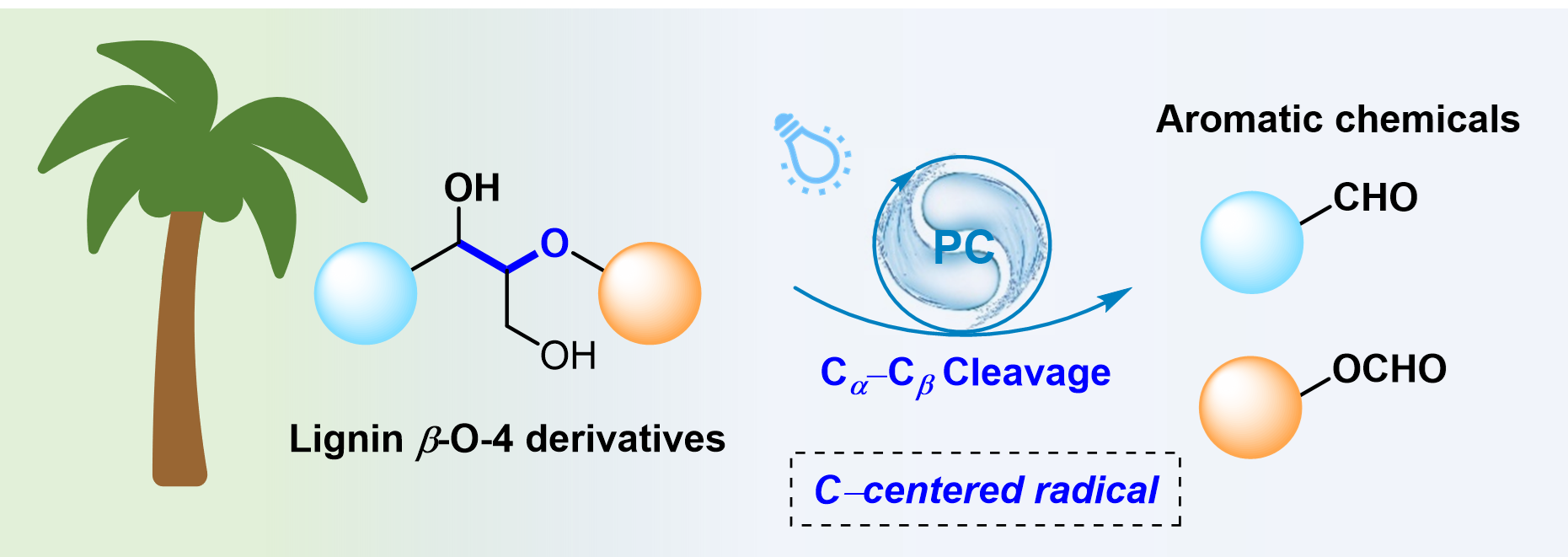
Yuting Liu, Huifang Liu*, Ning Li, and Feng Wang*
Applied Catalysis B: Environmental, 2023, 339, 123137, DOI: 10.1016/j.apcatb.2023.123137
Lignin presents a renewable alternative of fossil feedstock to produce value-added aromatic chemicals. Oxidative cleavage of C−C bonds in lignin is of great importance, but obtaining aromatic monomers in high selectivity under mild conditions is challenging. Herein, we report a novel strategy of photoinduced oxidative C–C cleavage of lignin β–O–4 derivatives using photoredox organocatalysts, among which Mes-10-phenyl-Acr+-BF4- exhibited high yields of aromatic aldehydes and phenyl formate. Besides, mixed binary organic solvents were demonstrated to promote bond cleavage and inhibit over-oxidation side reactions. Furthermore, through mechanism studies, a C-centered radical intermediate was captured, providing evidence for the direct Cα−Cβ bond cleavage mechanism during the reaction. This work presents a new photocatalytic strategy and provides deep insights into the bond cleavage mechanism for lignin valorization.
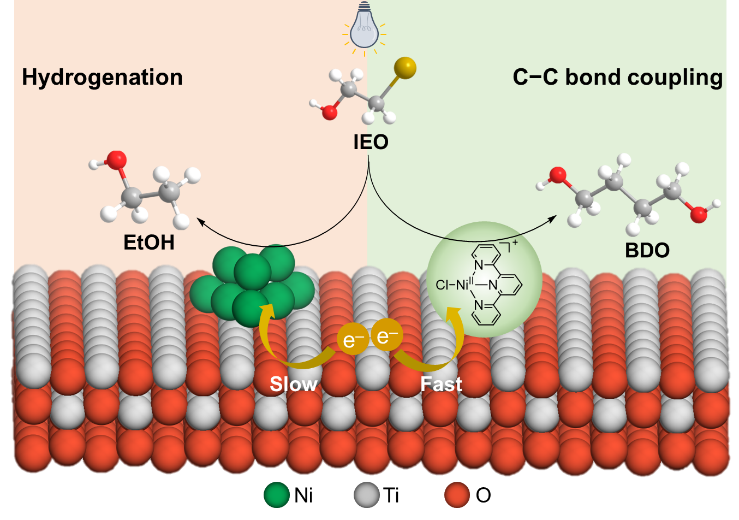
Qingchun Xu, Puning Ren, Yang Peng, Nengchao Luo,* Zhuyan Gao, Caixia Meng, Jian Zhang, Feng Wang*
Angew. Chem. Int. Ed., 2023, DOI: 10.1002/anie.202301668
Photocatalytic 2-iodoethanol (IEO) coupling provides 1,4-butanediol (BDO) of particular interest to produce degradable polyesters. However, the reduction potential of IEO is too negative (−1.9 vs NHE) to be satisfied by most of the semiconductors, and the kinetics of transferring one electron for IEO coupling is slow. Here we design a Ni-complex catalyst, which works synergistically with TiO2, realizing reductive coupling of IEO powered by photo-energy. Coordinating by terpyridine stabilizes Ni2+ from being photo-deposited to TiO2, thereby retaining the steric configuration beneficial for IEO coupling. The Ni-complex can rapidly extract electrons from TiO2, generating a low-valent Ni capable of reducing IEO. The photocatalytic IEO coupling thus provides BDO in 72% selectivity. By a stepwise procedure, BDO is obtained with 70% selectivity from ethylene glycol. This work put forward a strategy for the photocatalytic reduction of molecules requiring strong negative potential.
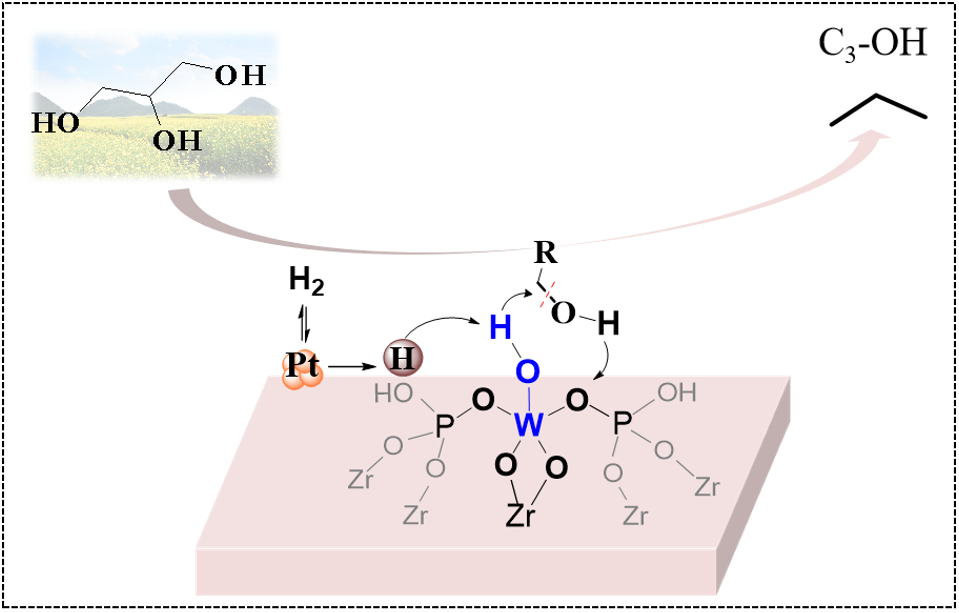
Huixiang Li, Yehong Wang⁎, Chaofeng Zhang, Zhipeng Huang, Jianyu Han, Xuezhong Nie, Feng Wang*
Applied Catalysis B: Environmental 325 (2023) 122342 DOI: 10.1016/j.apcatb.2022.122342
Brönsted acidity of Pt/WOx-based catalysts is crucial to efficient activation of C–OH bond in glycerol. Constructing strong Brönsted acidic sites (BAs) on catalysts is highly desired for efficient transformation of glycerol. Motivated by the source of Brönsted acidity in phosphotungstic acid, strong BAs were constructed on isolated WOx-modified Pt/zirconium phosphate (ZrPO4). Various characterizations confirm that the strong BAs on Pt-WOx/ZrPO4 are derived from the distinctive local structure of isolated W (V) oxides upon interacted with phosphate anion and zirconium center of ZrPO4 through O–W–O groups. In addition, the strong Brönsted acidity of Pt-WOx/ZrPO4 contributes to the efficient C–OH activation and producing 46.2% of C3 hydrocarbons in yield in glycerol hydrodeoxygenation, which is superior to that over other reported Pt/WOx catalysts.
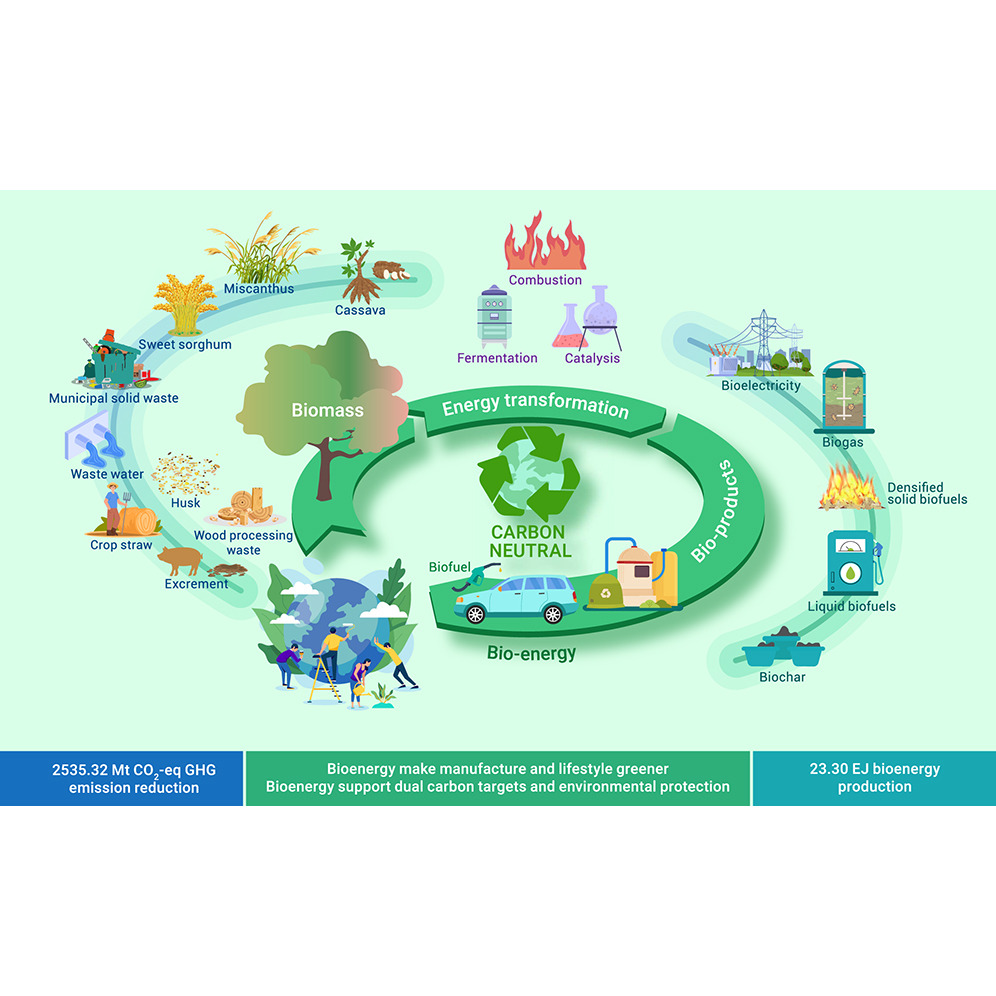
Jiaoyue Wang, Jingying, Zhitong Zhao, Longfei Bing, Fengming Xi*, Feng Wang*, Jiang Dong, Shiyun Wang, Gang Lin, Yan Yin, Qinqin Hu
The Innovation., 2023, DOI:10.1016/j.xinn.2023.100423
Here, a comprehensive bioenergy accounting model with a multi-dimensional analysis was developed by combining spatial, life cycle, and multi-path analyses. Accordingly, the bioenergy production potential and GHG emission reduction for each distinct type of biomass feedstock through different conversion pathways were estimated. When focusing on the carbon emission mitigation potential of substituting bioenergy for conventional counterparts, bioelectricity was the most effective, and its potential was 4.45 and 8.58 times higher than that of gaseous and liquid fuel alternatives, respectively. In this study, life cycle emission reductions were maximized by a mix of bioenergy end uses based on biomass properties, with an optimal 78.56% bioenergy allocation from biodiesel, densified solid biofuel, biohydrogen, and biochar. This study provides valuable guidance on exploiting untapped biomass resources in China to secure carbon neutrality by 2060.

Min Wang*, Hongru Zhou, and Feng Wang*
Acc. Chem. Res., 2023, DOI: 10.1021/acs.accounts.3c00039
This account will highlight our contributions in the research direction of the photocatalytic reforming of biomass into syngas (CO + H2). In 2020, we first reported the photocatalytic conversion of biopolyols and sugars into syngas by employing a defect-rich Cu-TiO2 nanorod photocatalyst and found that formic acid is a key intermediate to CO. Visible light-driven syngas generation was further achieved over a CdS-based photocatalyst. Besides, we put forward an oxygen-controlled strategy to increase the CO generation rate without a significant decrease in CO selectivity via controlling the O2/substrate ratio. Moreover, we also developed a photoelectrochemical approach to separately produce CO and H2 from biomass. This Account will systematically analyze the challenges in this research direction, the reaction route in the photocatalytic biomass reforming, and the factors affecting CO selectivity and give insight into the design of efficient photocatalytic systems.
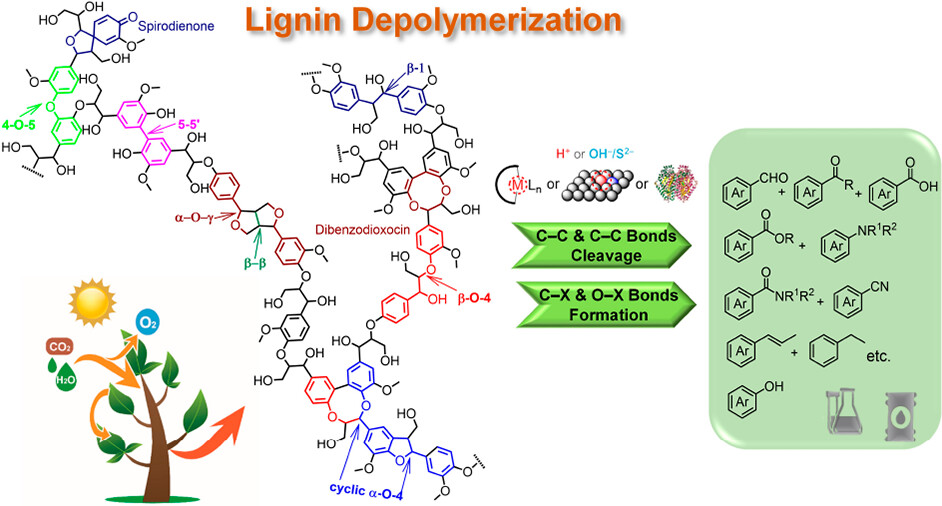
Chaofeng Zhang*, Xiaojun Shen, Yongcan Jin*, Jinlan Cheng, Cheng Cai, and Feng Wang*
Chem. Rev., 2023, DOI: 10.1021/acs.chemrev.2c00664
Lignin, as a precious resource given to mankind by nature with abundant functional aromatic structures, has drawn much attention in the recent decade from academia to industry worldwide, aiming at harvesting aromatic compounds from this abundant and renewable natural polymer resource. How to efficiently depolymerize lignin to easy-to-handle aromatic monomers is the precondition of lignin utilization. Focusing on the topic of lignin depolymerization to aromatic chemicals, this review reorganizes and categorizes the strategies/methods according to their mechanisms. The corresponding introduction involves the generation and the transformation chemistry of the critical intermediates. Accompanying the brief introduction of lignin chemistry and the final concluding remarks and perspectives on lignin depolymerization, this review aims to provide a current research process of lignin depolymerization, which may provide useful suggestions for this vigorous research field.
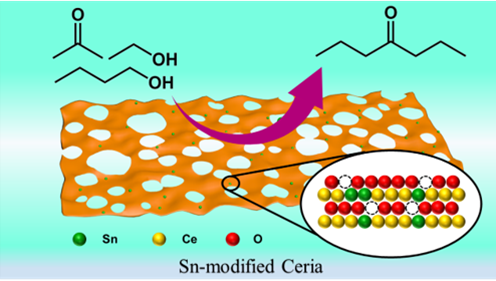
Yafei Liang, Yehong Wang*, Zhixin Zhang, Jianyu Han, Jian Zhang, Yuda Zhang, and Feng Wang*
ACS Sustainable Chem. Eng., 2023, 11, 5858–5866, DOI: 10.1021/acssuschemeng.2c05592
The conversion of biomass-derived oxygenates to sustainable chemicals and renewable fuels is a desirable path, while designing efficient catalysts is key to this process. However, efficiently exposing active sites still remains a significant challenge for improving catalytic performances. In this study, a defective porous Sn-modified CeO2 (Sn-CeO2–BM) catalyst was developed via a facile ball milling-pyrolysis strategy. It showed an excellent catalytic performance in the selective conversion of biomass-derived acetone–n-butanol–ethanol (ABE) fermentation to 4-heptanone. The conversion over Sn-CeO2–BM achieved 95% with 82% liquid selectivity of 4-heptanone, which were superior to those over other conventional Sn-modified CeO2. It was concluded that the efficiently exposed active sites of Sn species and defect sites lead to an excellent catalytic performance of Sn-CeO2–BM. This work proposes a facile way to design and synthesize highly efficient porous CeO2-based catalysts.
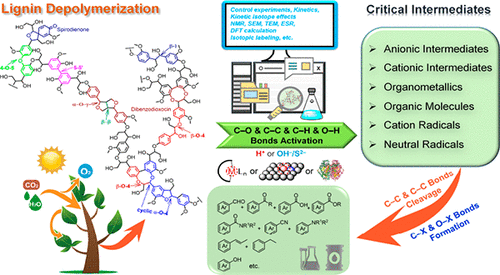
Chaofeng Zhang*, Xiaojun Shen, Yongcan Jin*, Jinlan Cheng, Cheng Cai, Feng Wang*
10.1021/acs.chemrev.2c00664
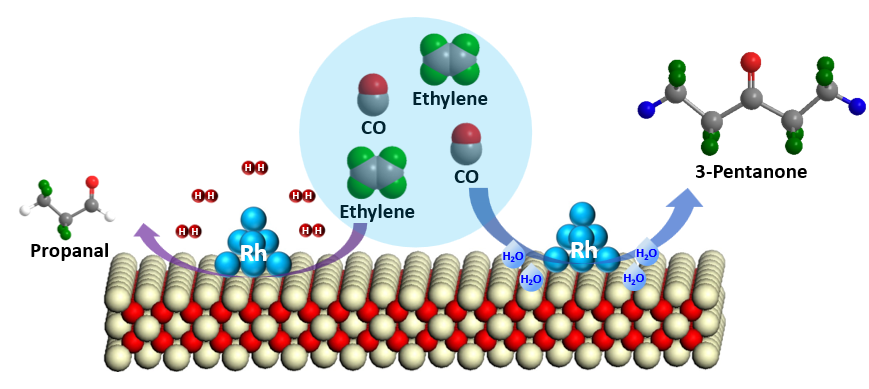
Kun Zhang, Qiang Guo*, Yehong Wang, Pengfei Cao, Jian Zhang, Marc Heggen, Joachim Mayer, Rafal E. Dunin-Borkowski and Feng Wang*
ACS Catal. 2023, 13, 3164−3169, DOI: 10.1021/acscatal.2c06123
Alkene carbonylation, in which hydrogenation plays pivotal roles, is one of the most efficient ways for the production of oxygenated chemicals. In this work, by using in-situ produced hydrogen via water-gas-shift (WGS) reaction, selective ethylene carbonylation to 3-pentanone was achieved instead of hydroformylation to propionaldehyde with gaseous H2 on a defective ceria supported Rh catalyst. The interface of Rh/CeO2 which consists of oxygen vacancy and positively charged Rh activates water, CO and ethylene and the subsequent reactions. The lean hydrogen circumstance created by WGS reaction which suppresses the hydrogenation of the propionyl group and promotes its ethylation to 3-pentanone. Redox pathway was proposed for WGS reaction based on the in-situ FTIR results and the origin of hydrogen for ethylene carbonylation is water as confirmed by mass spectrometry (MS) study by using d2-water as one of the reactants. This work provides a promising way for heavier ketone synthesis.

Puning Ren, Zhuyan Gao, Tiziano Montini, Zhitong Zhao, Na Ta, Yike Huang, Nengchao Luo*, Emiliano Fonda, Paolo Fornasiero*, Feng Wang*
Joule, 2023, DOI: 10.1016/j.joule.2023.01.002
The main obstacle to high H2 yield is the far insufficient C–C bond breaking to convert biomass carbons into CO2 with maximization of H2 production. Here, we emphasize C–C bond breaking instead of direct H2 production. Such a “C–C bond first” strategy realizes conversion of carbohydrates into C1 liquid hydrogen carriers (LHCs, consisting of HCOOH and HCHO) over Ta-CeO2 photocatalyst and is demonstrated in a flow apparatus powered solely by solar energy. The LHCs can release H2 on-site where needed by either photocatalysis or thermocatalysis. This work provides a new perspective for H2 production by photocatalysis.

Zhipeng Huang, Yang Yang, Junju Mu, Genheng Li, Jianyu Han, Puning Ren, Jian Zhang, Nengchao Luo, Ke-Li Han and Feng Wang*
Chin. J. Catal., 2023, 45, 120-131, DOI: 10.1016/S1872‐2067(22)64181‐0
Radicals are key intermediates in numerous reactions. Their high reactivity enables various transformations to occur under mild conditions, however, also brings great challenges to control their reactions especially over heterogeneous catalysts. Here we propose to use metal nanoparticles to directly steer the conversion of free radical species. Results from photocatalytic reactions, in situ transient absorption spectroscopy, and theoretical simulation demonstrate that supported Pd nanoparticles can efficiently stabilize free radical species generated from photo-excited TiO2, and thus manipulate their conversion on catalyst surface, owing to the enhanced electronic interactions between metal and radical species. These understandings are crucial for the design of advanced heterogeneous catalytic systems with controllable radical reactions.
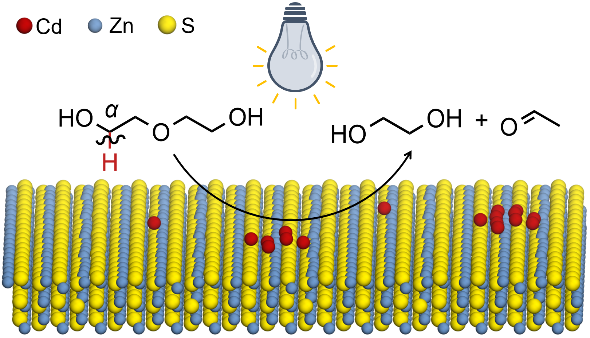
Lulu Sun, Yike Huang, Shiyang Liu, Xiumei Liu, Nengchao Luo,* Feng Wang*
Chem. Commun., 2023, DOI: 10.1039/d2cc06649a
C−O bond scission via photocatalysis is an important step in biomass depolymerization. Here, we demonstrate the scission of strong ether C−O bonds promoted by low-work-function Cd single atoms and clusters. Their loading on ZnS benefits C−H bond scission, thus weakening the C−O bond for the chemical bond breaking.